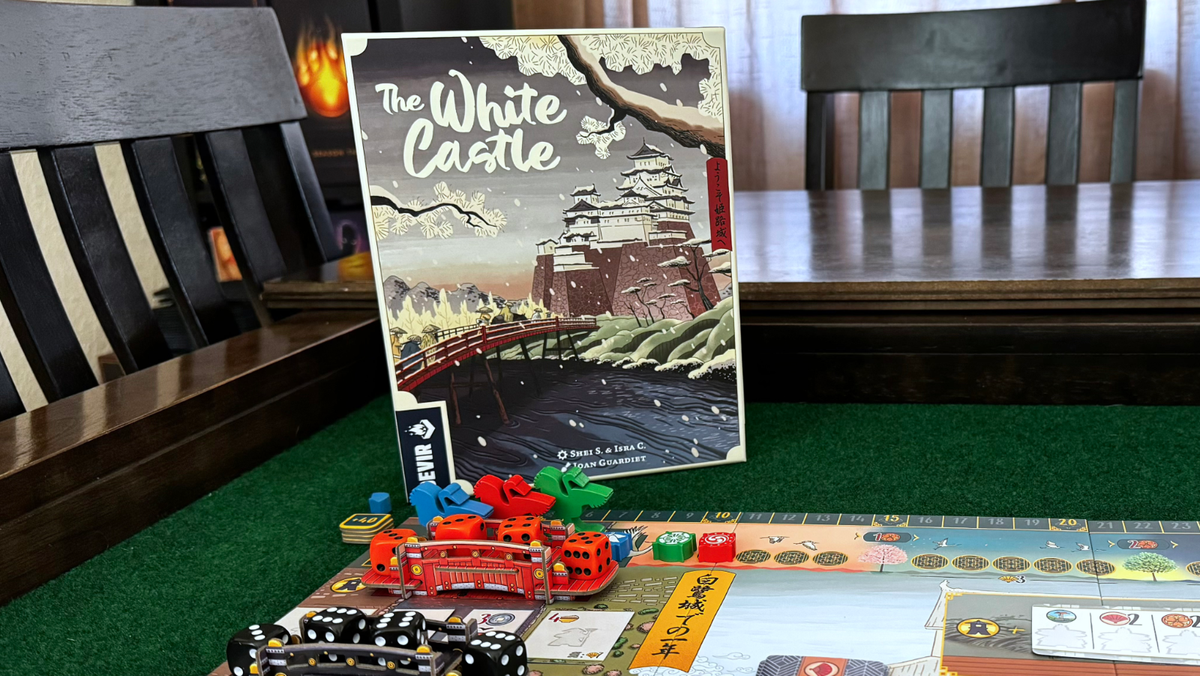
Value. Value is largely subjective by nature- each of us places value on things to varying degrees and often the value we ascribe to those things in turn varies from person to person. Furthermore, one individual can find boundless value from a thing while another sees no value whatsoever in that same thing. Value can have any manner of adjectives placed before it to instill a more specific sense of the value trying to be communicated, such as monetary value, or, to actually bring it into the realm of games finally, play value. Now that I’ve likely bored you with describing something you already know (and have you wondering about the value of the point I’m even trying to get at), let me throw you a curveball, because I want to put forth the idea that some things are just so irrefutably good that their value could be considered objective rather than subjective by nature. That a thing can have impressive amounts of value across enough adjectives to cross over into objectivity. This is just my opinion, of course.
The White Castle, designed by Llama Dice Games and published by Devir (the team that brought you Red Cathedral), is such a thing. At least I think so, and I’m going to tell you why.
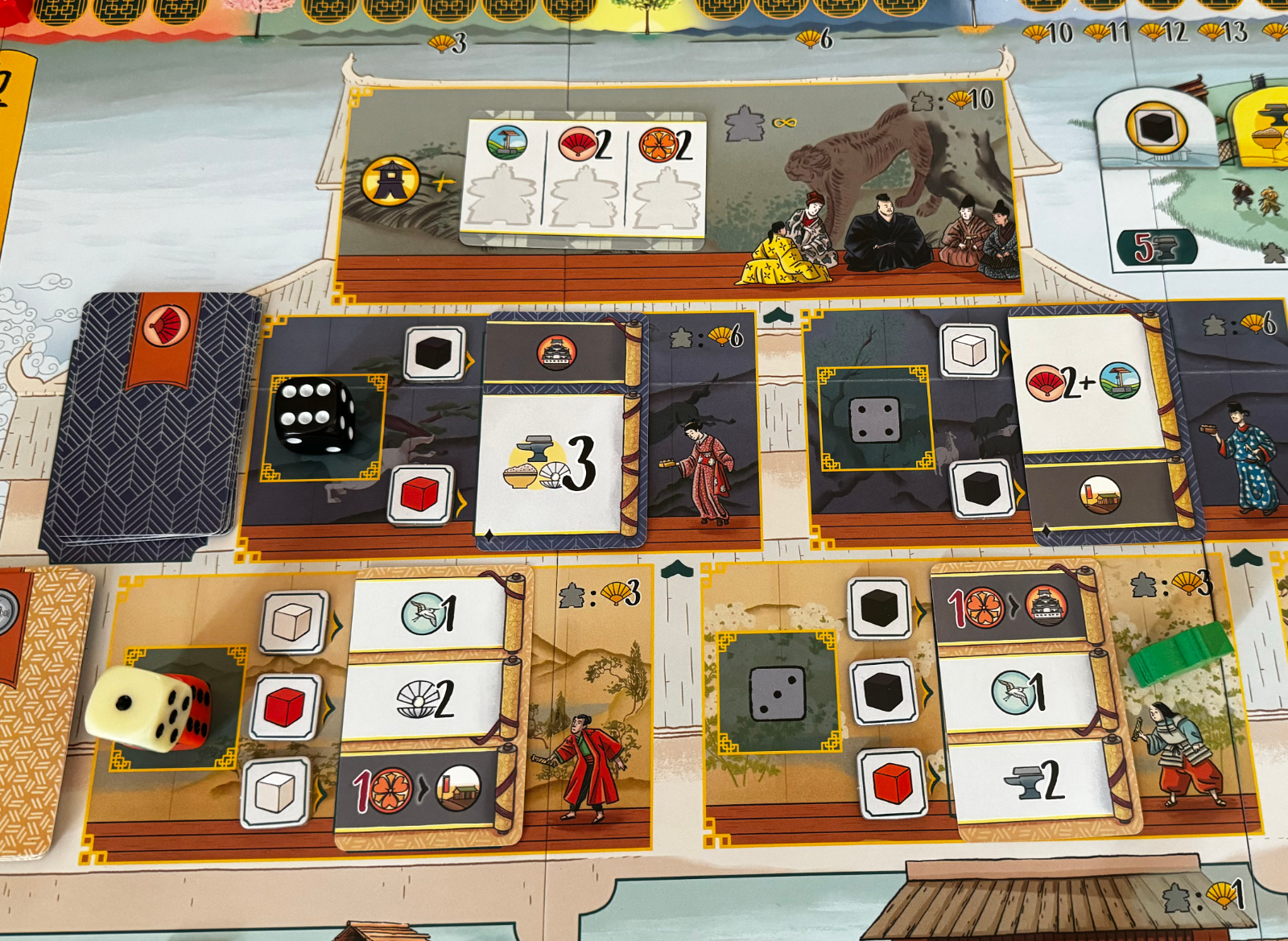
The titular White Castle
First, let’s look at the mechanics and gameplay of this tight little mixture of dice placement, worker placement, and engine building, which may or may not surprise you is totally devoid of anything hamburger related. In fact, the setting of the famous Himeji Castle during the feudal era of Japan has very little bearing on the game, providing little beyond a patina of visual elegance. The framing does work, but some of the theme based iconography can be a bit to wrap your head around at first. The central mechanic of The White Castle is dice placement. During the three rounds of the game, three sets of different colors of dice are rolled and placed on the matching colored bridge in numerical order from lowest to highest. The amount of dice rolled is determined by the number of players, which guarantees that however many players there are, each one only gets three dice to place per round, leaving three dice on the bridges at the end of the round. Each player turn is determined by the color and number on the die placed, and different placements yield different bonuses, costs, worker placement action or a combination thereof.
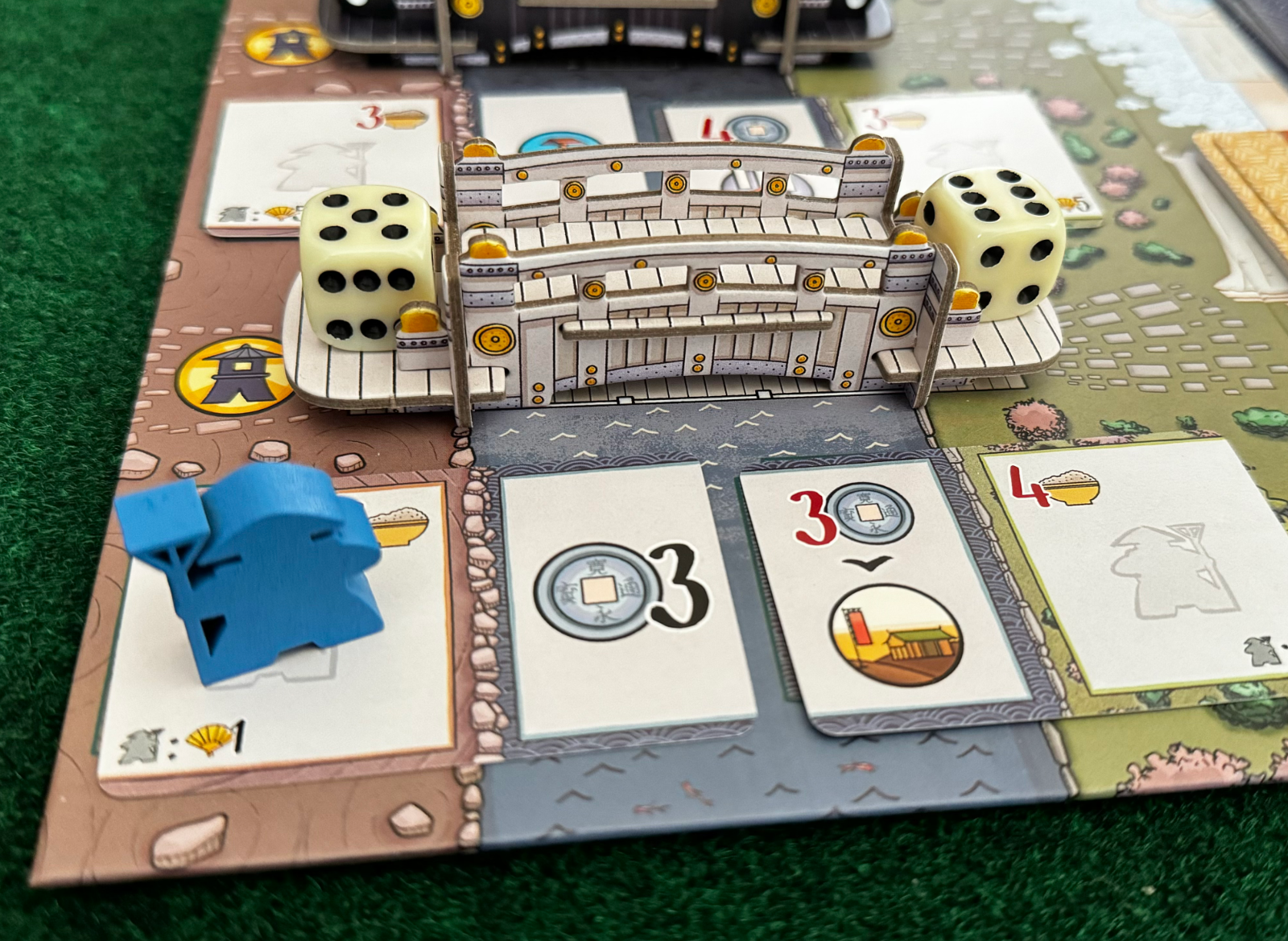
The Gardener at work
There are three worker placement actions a die can activate, and each one represents an area of the board and a specific type of worker. The gardener action allows a player to place one of their gardener meeples on one of the six randomized garden cards placed near the bridges. This will always cost some amount of food (one of the three primary resources, counted on the player mat track, one for each area of the board), will trigger an action or grant resources, usually at an additional cost, and most importantly, scores additional points at the end of the game. If the final dice left at the end of a round are left in a space above an occupied garden, that player can activate the garden card’s ability again (Frankly, this didn’t happen as often as you might think). After several games of The White Castle at various player counts, it felt like this action was more situational than the other two, largely due to how expensive placing workers there could be. In games where the random setup elements provided for easy to acquire food and coin, they saw a lot more action. If food in particular was hard to come by, however, then those gardens were largely left untended.
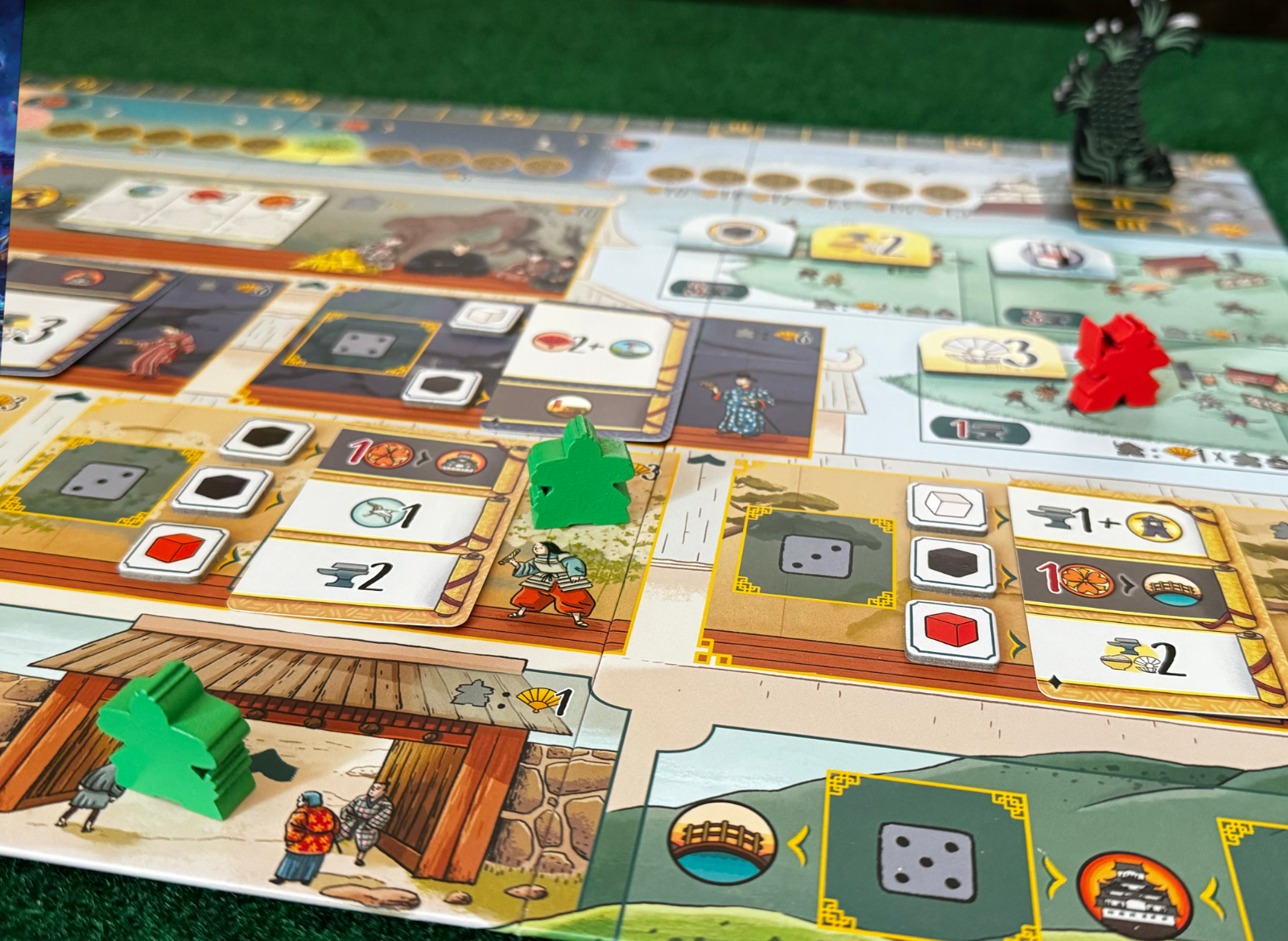
Courtiers maker their way up the castle
The courtier action, on the other hand, became a vital part of a winning strategy in every game. Most of the board is taken up by the three levels of the castle and the castle gates, where courtier meeples start their journey upwards for two coins. Additional levels can be traversed for pearls, and the rooms in levels one and two have cards that indicate the action associated with the die slot to it’s left. Moving a courtier into that room lets the player claim it’s card and putting it in the card area on their player board (taking one action on the taken card for free), replacing the card that was there which now gets flipped over and added to the lantern action below (which is VERY good, more on that later). Get all the way to the top and you get to trigger a lantern action in addition to one of three choices on a card from another deck that was randomly selected during game setup. Each level yields progressively more points at the end of the game, even the gates!
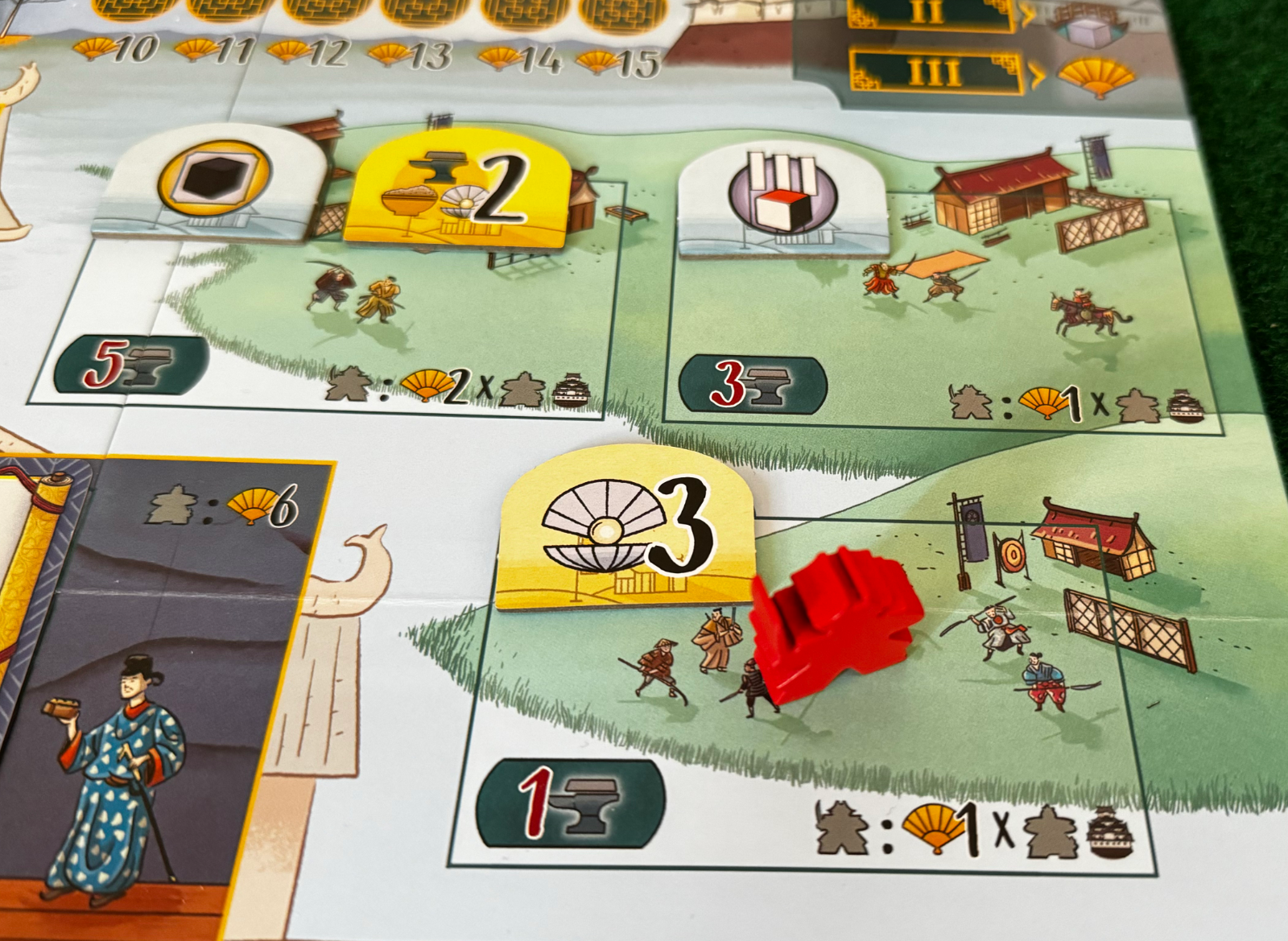
A Warrior enters the training ground
Finally, the warrior action allows a player to place a warrior in one of the three training yards, costing two, three, or five iron respectively. Each of these spots has a randomly selected tile with an ability that gets activated when the warrior is placed there, with the most expensive yard having two such tiles. The utility of these three spaces can vary from game to game depending on which ability tiles come out, but the real reason to empty your board of warriors is that they act as multipliers at the end of the game for the number of courtiers in the castle. I found that focusing on the symbiosis of those two worker types lent itself to racking up huge points at the end of the game.
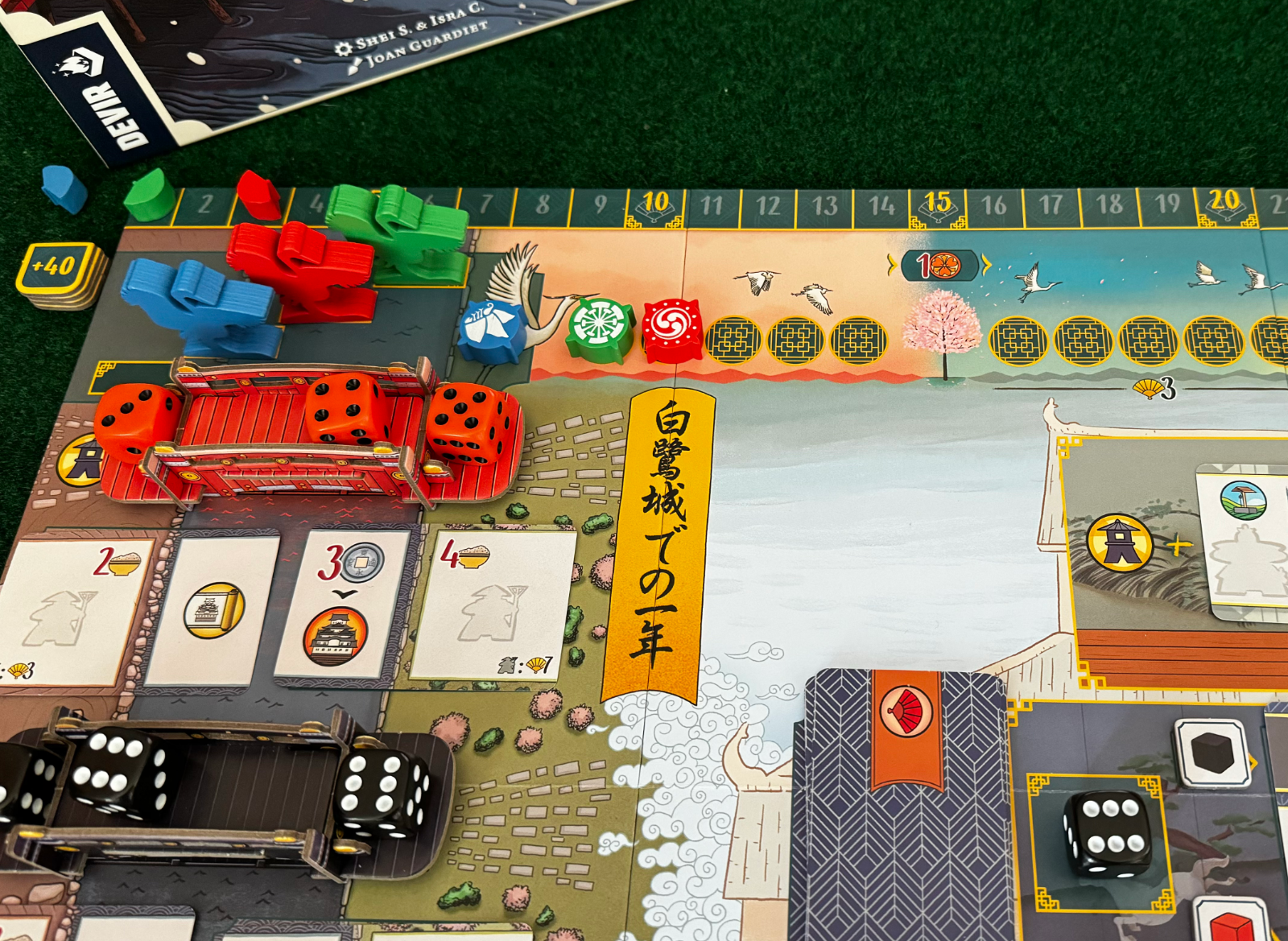
All of the rest of the dice placement in the game yields resources, moves a player’s influence token further up the Passage of Time track (which determines player turn order each round), or triggers a Lantern Action. Even the player boards have die slots, one for each color, corresponding to the three rows of workers on the board, allowing for what is called a Personal Domain Action. As courtiers, warriors and gardeners are placed on the main board, resource icons are revealed. When a Personal Domain Action is taken, all of the revealed icons on the row yield the appropriate resources, and the action on the card at the end of the row is taken. How often this is done each game generally depends on the board state established during setup, so swapping out those cards by moving courtiers up the castle is potentially a game changer.
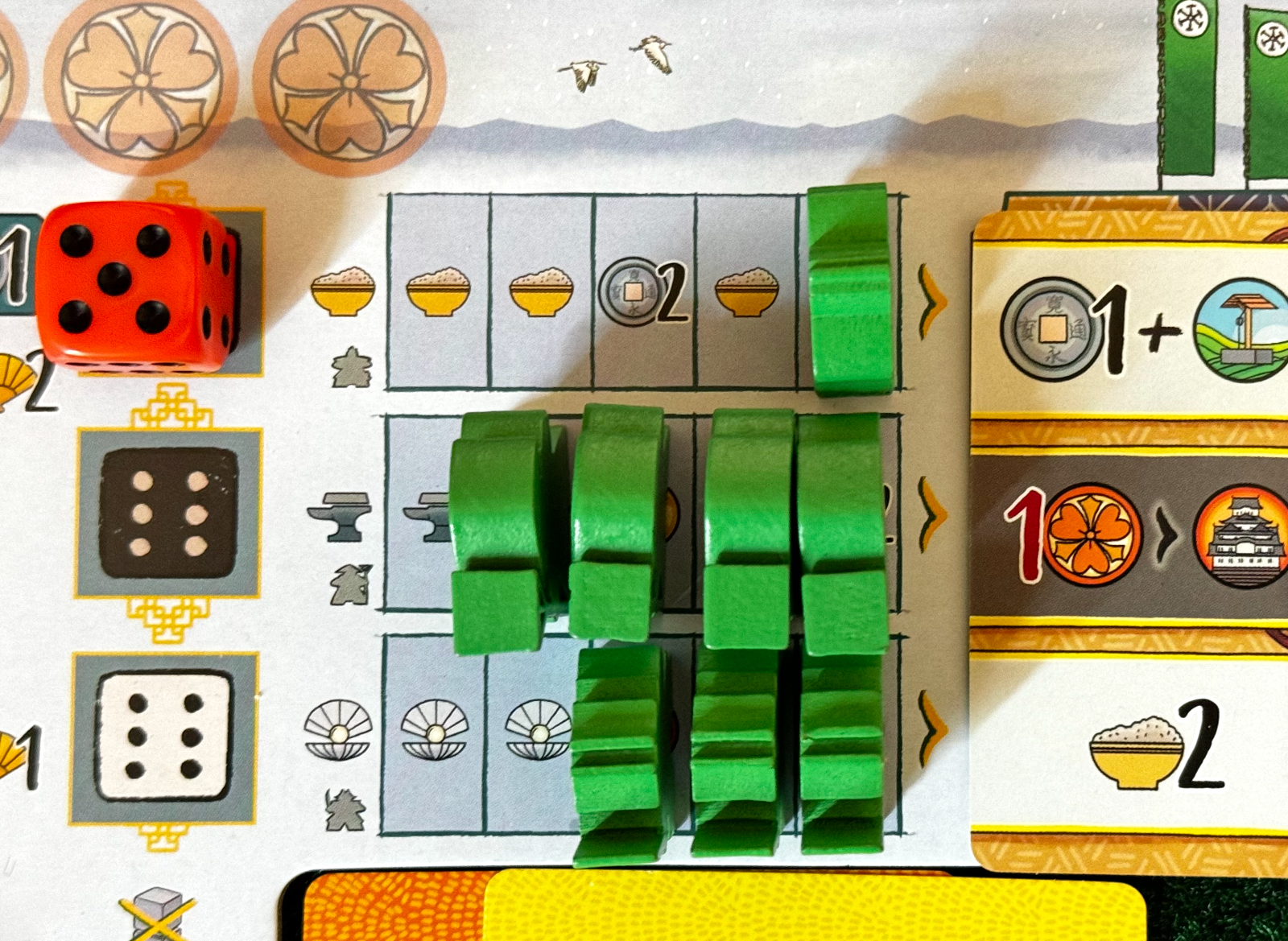
I’ve already brought it up a few times, hinted at it, so let’s talk about one of my favorite parts of the game: the Lantern Action. There are two different ways to trigger the Lantern Action, and you can trigger it multiple times in a single turn. The most obvious way to trigger it is by placing a die that corresponds to the action on a card or on the board. The interesting way to trigger it is by taking a die on the left side of the bridge, often requiring a sacrifice when placing the die due to paying the value difference in coin rather than gaining it like a higher value die would. Now, at the beginning of the game, this is more like a nice little bonus, but as you move courtiers up the castle and claim cards, your current personal domain action card flips over and moves down to an ever growing Lantern Action, bringing you everything from resources, to influence, to coins, to points. Eventually you hit that one turn just right where you end up triggering the lantern two or three times and it’s like hitting a jackpot.
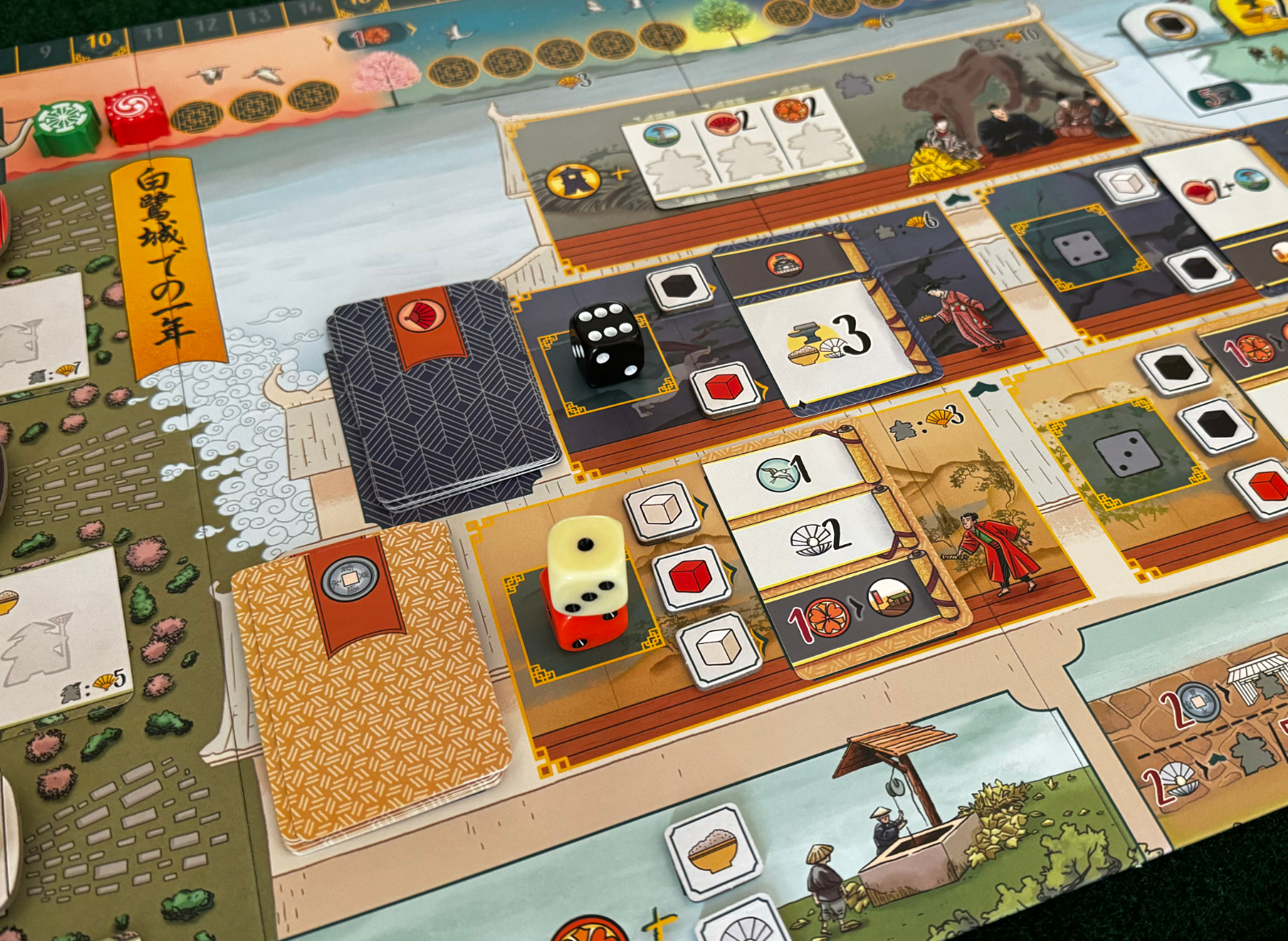
It’s the capacity of chaining actions like that, and even the possibility of doing so in the early part of the game, where The White Castle really starts to shine. These chain reactions can go deep, and taking a one-and-done action feels like a missed opportunity in a game where each player only gets nine total turns. Conversely, when a single turn has you fiddling with nearly every corner of the game board, the resulting dopamine spike might just remind you why you got into this hobby in the first place.
I’m going to let you in on a little secret- sometimes when reviewing a game, we reviewers will occasionally misread or omit a rule and play the game incorrectly a few times. Now, this is a problem if the mistakes are never caught or if the game is never played correctly, but more often it becomes an accidental blessing and underscores and reveals where some of the decision making involved led to the rules in question. The first three or four games I played of White Castle, each play had one small omission or misplay, and as I corrected with each consecutive play, layering in each missed rule, my opinion of the game went from “good” to “great”. When that final rules mistake got corrected, the quibbles and nitpicks I had (especially with how tight the game was and how badly I wished I had just one or two more turns) melted away, and the true balance of the game lay revealed to me. Now, I wouldn’t go so far as to say that the rules for the game are written poorly, but, like everything else in this tiny box, they are very dense.
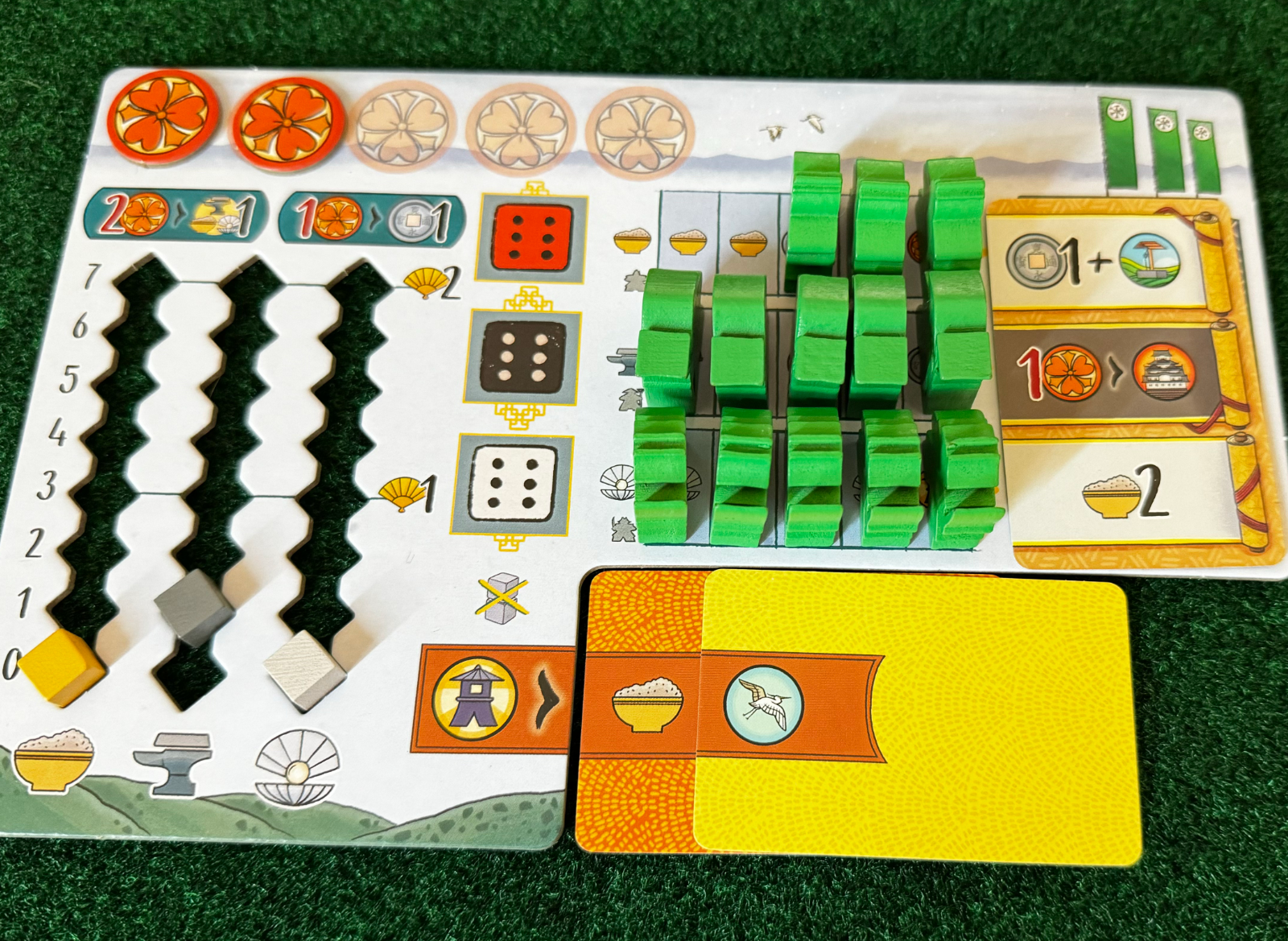
This player’s Lantern action is growing
That so much game is packed into such a small box for such a low price is utterly refreshing in these days of cardboard crowdfunding excess. This $30 box is dense, has to be packed just so, and any thoughts of an organizer or room for an expansion are laughable at best.If the box was any smaller, I’d be wondering if it was a TARDIS. Component quality, much like the gameplay, presents as a much bigger more expensive game. Frankly, the whole package may be one of the best values I’ve seen in this hobby for years, and will likely land in my top five games of the year at this point.
The White Castle
Excellent
A tiny box with a ton of game, The White Castle is a tight yet satisfying mid-weight worker placement game with a ton of replayability. The combination of dice-placement and worker placement and the capacity to kick off chain reactions with wild abandon make this one of the best games in this class for years, and the small price tag just means there’s really no excuse to add it to your collection. Expect to see this one on some end-of-year lists.
Pros
- Very tight time-boxed game
- Lots of satisfying moments when chaining actions
- Tons of replayability with randomized board state during setup
- Huge value at only $30-40 price tag
Cons
- Sometimes you wish you had more turns
- Storage is tight and precise with no option for organizer
- Iconography takes some getting used to